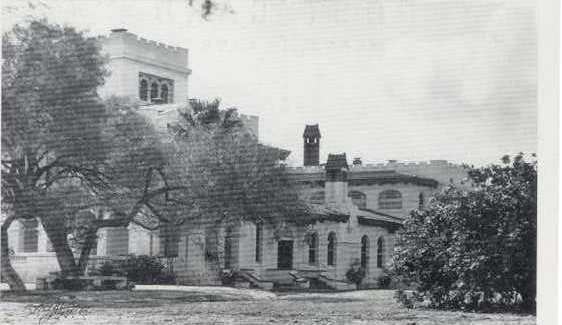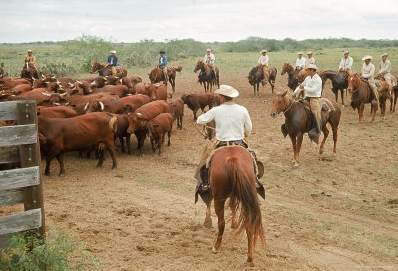|
Advertisments |
||
|
||
|
||
|
|
||
|
||
|
|
Richard King an ex river boat captain and an Texas ranger and militiaman Gideon Lewis, better known as “Legs Lewis for his tireless marching during the Mexican hostilities had fell in love with Santa Gertrudis area in Texas. Lewis considered the area as a rancher’s paradise, and King agreed with him. Though the railroad would not come for another 15 years, King plunged into ranching with impatient optimism. He purchased 15,000 acres for $300 in July 1853 from the Mendiola family. He later purchased another 53,000 acres for $1,800 adjacent to his property to the west. To ready the ranch for livestock, King and Lewis set their men to work building a rough dirt dam to trap water from a stream near their headquarters. By 1854 when a long drought gripped Mexican ranchers across the Rio Grande, the Santa Gertrudis had plenty of stored water and the captain was able to by thirsty, bony Mexican livestock at depressed prices. In the border towns of Mier and Camargo, he bought up animals of all sorts-not just cattle but also sheep, goats and horses. King was only being practical in deciding to spend money for horses instead of capturing wild mustangs free of cost. He needed tractable mounts at once and could not afford the long hard work of breaking and training the defiant mustangs.
King also looked to Mexico for ranch workers and skilled riders to tend his cattle herd and horse corral. King offered vaqueros 25 pesos a month plus board and keep-equal to the minimum of $25 a month paid to American cowboys.
King also offered fringe benefits-a tactic that would not occur to many western ranchers for years. His master plan for staffing his ranch evolved during a purchasing trip south of the border. At a drought stricken village below Camargo, he bought all the livestock available. Then, realizing that the villagers were left without a business to sustain them, he made them an offer: if they would come to work on the Santa Gertrudis, they could build homes of their own. The villagers recognized this arrangement, which resembled the feudal form Mexican ranching had taken since the days of the Spanish conquistadors. Having no better alternative, they agreed to King’s offer and accepted him as their patron, or protector.
More than 1,000 villagers-men, women and children-pulled up stakes and started north. They travelled in a long, noisy caravan, riding rickety two-wheeled carretas, pushing wheelbarrows full of clothes and household goods. On reaching the Santa Gertrudis the villagers soon learned that King was firm and demanding but-unlike the typical patrones they knew earlier-always fair and even kindly, taking a personal interest in their wellbeing. They gave him their unqualified loyalty and became the nucleus of Los Kinenos-the King People, as the ranch workers and their families came to be called. They, their children and their children’s children would live and work on the king ranch, secure and respected as productive members of a self-sufficient society.
News of Kings ambitions operations aroused lively curiosity to the North and South. Once or twice Mexican outlaws tested the ranches defences, but Los Kinenos were handy with rifles and drove off the raiders; soon the Santa Gertrudis was left alone, except for minor rustling and an occasional sniper. In turn, the newfound peace along Santa Gertrudis Creek interested prospective ranchers. Encouraged by Kings strong stand, Texans began moving south, claiming land and starting other ranchers in the Wild Horse Desert. They regarded King as their leader.
Two events in the mid-1850s ended the formative stage of Kings ranching business. One was a shocker that deprived King of his debonair partner. Legs Lewis was shot to death in Corpus Christi by the irate husband of his latest paramour. Lewis ‘death saddened King, but it enabled him to strengthen the business structure of the ranch. Now King incorporated the Santa Gertrudis under the name R. King and Company and got two new partners with sizeable capital to put into it. One was Kings old partner in the riverboat company Mifflin Kenedy; the other was James Walworth, a steamboat captain who would be a silent partner.
The second milestone was a happy one. With the ranch solidly established, Richard King had a permanent home-though not yet a castle-to offer Henrietta Chamberlain and the time had come to marry her. After formally courting like a gentleman he finally got what he sought. On December 10, 1854, after the evening service at the Reverend Hiram Chamberlain’s First Presbyterian Church in Brownsville, King left his seat and Henrietta left her usual place in the choir, and her father pronounced them husband And wife before the whole congregation.
King took his bride to Santa Gertrudis in a stagecoach he had bought for the occasion. As they neared the ranch, grinning vaqueros rode out to greet the new Mrs King-la Patrona. Henrietta was happy with her home, and she wrote. “I doubt if it falls to the lot of any bride to have had so happy a honeymoon. On horseback we roamed the broad prairies. When I grew tired my husband would spread a Mexican blanket for me and then I would take my siesta under the shade of the mesquite tree.”

The King Ranch grew from a framed building to a huge structure boasting 10 bedrooms. In 1912 it was destroyed by fire - reportedly started by a disgruntled gardner.

Home <> Western Gallery <> Western Dictionary <> Cowboys <> Reining
Western Store <>Western Writers <> Western Stars <> Western TV <> Country Music <> Guns <> Western Vacations


